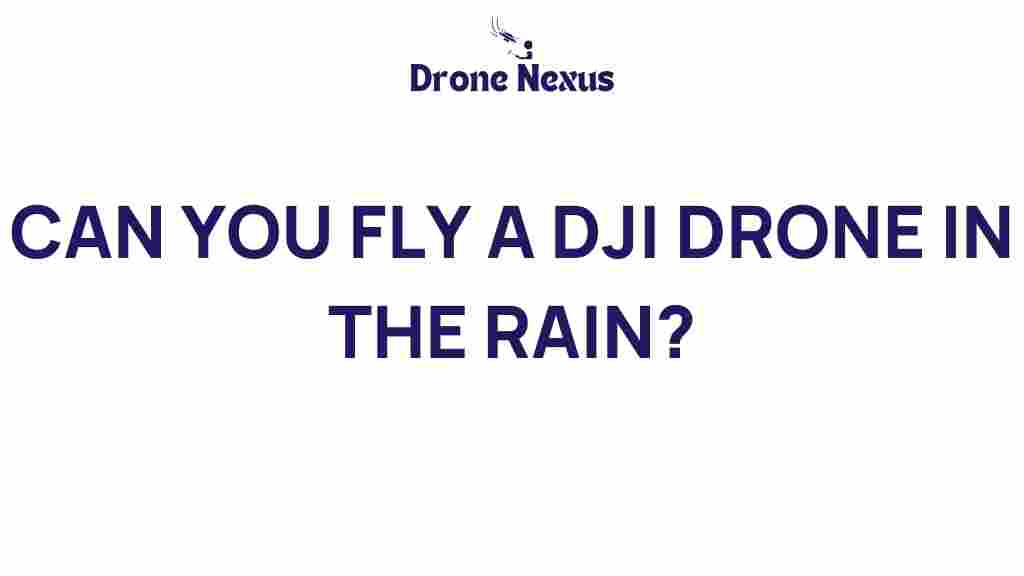The Truth About Flying a DJI Drone in Rainy Weather
When it comes to flying a DJI drone, the weather plays a critical role in determining your flight experience and the safety of your equipment. Among various weather conditions, rainy weather can pose unique challenges and risks to drone enthusiasts. In this comprehensive guide, we will explore the implications of flying a DJI drone in the rain, what precautions you should take, and how to safely navigate adverse weather conditions.
Understanding the Risks of Flying a DJI Drone in Rain
Before you decide to take your DJI drone out for a spin in the rain, it’s important to understand the potential risks involved:
- Water Damage: Most DJI drones are not waterproof, and exposure to rain can lead to electrical failures or corrosion.
- Reduced Visibility: Rain can reduce visibility, making it harder for you to maintain a line of sight with your drone and increasing the risk of collisions.
- Wind and Turbulence: Rain often accompanies wind, which can affect your drone’s stability and control.
- Battery Performance: Cold and wet conditions can affect battery performance and flight time.
DJI Drone Models and Their Weather Resistance
Different DJI drone models come with varying levels of weather resistance. Here’s a quick overview:
- DJI Mavic Air 2: This model offers some resistance but is not designed for heavy rain.
- DJI Phantom 4 Pro: This drone has a degree of water resistance but should still be kept away from direct rain.
- DJI Mavic 3: With improved weather sealing, this model can handle light rain but is not waterproof.
Always check the specifications of your specific model before flying in adverse weather conditions.
Precautions to Take Before Flying a DJI Drone in the Rain
If you determine that the rain is light and your DJI drone is capable of handling it, follow these precautions:
- Check the Weather Forecast: Ensure that the rain is not expected to intensify and that wind conditions are manageable.
- Inspect Your Drone: Before flight, thoroughly check your drone for any signs of wear or damage, especially around the battery and motors.
- Use a Rain Cover: If possible, use a drone rain cover or waterproof case to protect your equipment.
- Keep Flight Times Short: Plan for shorter flights to minimize exposure to rain.
- Have a Backup Plan: Be prepared to land your drone quickly if conditions worsen.
Step-by-Step Process: Flying a DJI Drone in Light Rain
Here’s a step-by-step guide to safely flying your DJI drone in light rain:
- Pre-Flight Checklist: Ensure all components are functioning, batteries are charged, and firmware is up to date.
- Set Up Your Flight Area: Choose a clear, open area for takeoff and landing, away from trees and buildings.
- Takeoff: Launch your drone and maintain a close watch on its performance. Avoid aggressive maneuvers.
- Monitor Conditions: Continuously evaluate the weather conditions during your flight. If the rain intensifies, it’s time to land.
- Land Safely: When you’re ready to land, do so gently and ensure the landing area is free from obstacles.
Troubleshooting Tips for Rainy Weather Flights
Even with precautions, issues can arise when flying a DJI drone in the rain. Here are some troubleshooting tips:
- Drone Malfunctions: If your drone starts acting erratically, land it immediately and check for water damage.
- Battery Alerts: If you receive battery alerts, land your drone as soon as possible to avoid power loss.
- Signal Loss: If you experience a loss of signal, return to home mode to ensure a safe landing.
Post-Flight Care After Flying in the Rain
Once you’ve flown your DJI drone in the rain, proper care is essential:
- Dry Your Drone: Gently wipe down the exterior with a microfiber cloth to remove moisture.
- Inspect Components: Check the battery, motors, and camera for any signs of water intrusion.
- Store Properly: Store your drone in a dry, well-ventilated area to prevent moisture buildup.
When to Avoid Flying Your DJI Drone in Rain
There are certain conditions under which you should avoid flying your DJI drone in the rain completely:
- Heavy Rain: If there’s heavy rain or a storm, it’s best to stay grounded.
- Severe Wind: Wind gusts can make flying dangerous, especially in combination with rain.
- Low Visibility: If the rain is heavy enough to limit visibility, it’s time to postpone your flight.
Conclusion: Making Informed Decisions
Flying a DJI drone in rainy weather can be a challenging yet rewarding experience if done correctly. Understanding your drone’s capabilities, weather conditions, and safety precautions will help you make informed decisions. Always prioritize safety, and when in doubt, opt for a safer, drier day for your drone adventures.
For more information on DJI drones and flying tips, be sure to check out our detailed guide.
If you want to learn more about drone regulations and safety tips, visit this external resource.
This article is in the category Safety and created by DroneNexus Team

2 thoughts on “The Truth About Flying a DJI Drone in Rainy Weather”